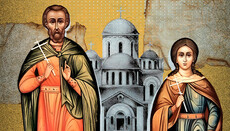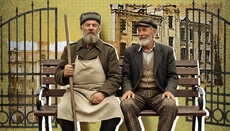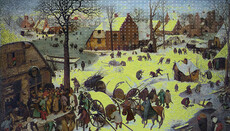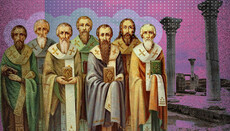How Renovationist schismatics were received into the bosom of the Church
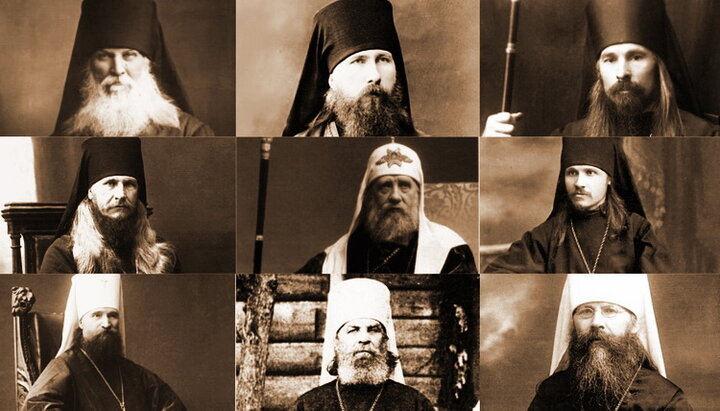
The wound of schism is now gnawing at the Ukrainian Church. But we look with hope at our holy new martyrs, who were able to overcome the early 20th century schism.
The Church is intrinsically one. There cannot be two Churches. Those who are not in our Church, who broke off with Her, are outside the Church. It has always been and will be so.
The wound of schism is now gnawing at the Ukrainian Church. However, the schism has struck the Body of the Church not for the first and, most likely, not for the last time. This is a reality which you will have to, if not accept, then somehow handle. That is why we look with hope at our holy new martyrs, who at one time succeeded in overcoming the schism of the 1920s and 1930s.
Excommunicating from Herself and taking back into Her bosom, the Church is guided by the principle worded by Her Head: “Truly I tell you, whatever you bind on earth will be bound in heaven, and whatever you loose on earth will be loosed in heaven” (Matthew 18:18). Measures of excommunication should not cause any surprise, since such norms are based on Christ's words: "If they still refuse to listen, tell it to the church; and if they refuse to listen even to the church, treat them as you would a pagan or a tax collector" (Matthew 18:17). According to the rule of St. Basil the Great, the schismatics, by virtue of their mere break with the Orthodox Church, are already becoming laymen, moreover, they are not even Orthodox.
The essence of the Renovationist schism can be summed up to the ideology that the living churchmen began to promote in the Church for the sake of secular power. The state said, “The people are made up of classes. One class has the right to exterminate the other." The Church teaches that the people are made up of brothers and sisters. The renovationists conciliarly recognized capitalism as a mortal sin. In their ideas, the schismatics went as far as revising dogmas, which, in their opinion, are filled with capitalism and neo-Platonism. The Last Judgment, Heaven and Hell were interpreted as allegorical and moral concepts, while the creation of the world was postulated as a creation "with the participation of the forces of nature". The schismatics treated the parish and parishioners primarily as a “labor commune”.
“I cannot be a traitor to the Orthodox faith, and I don’t want to please the Soviet regime like the renovationists. Renovationism is a trend hostile to religion and is aimed at the destruction of religion. I am the enemy of this."
Hieromartyr Elijah (Benemansky)
Such indulgence of the authorities could not but repel. During interrogation, Hieromartyr Elijah (Benemansky) expressed all the results of such a religious policy in the schism: “I cannot be a traitor to the Orthodox faith, and I don’t want to please the Soviet government like renovationists. Renovationism is a trend hostile to religion and is aimed at the destruction of religion. I am the enemy of this."
Many left for the split for political reasons, eager to be with the "people", i.e. the "red" church. However, after a while they realized that the Church could not take such a vivid political position. One of the new martyrs wrote, “Our attitude to power, commanded by the apostle, has not changed. Power often wants what belongs to God. And from this arise misunderstandings in relations with the Church. The Church will cease to be the Body of Christ if She gives Her strength to Caesar and bows down to his tasks, forgetting the Gospel."
The episcopal wisdom of the times of persecution was right: many who have gone into schism would return to the Church once they understood its true essence. Therefore, the clergy who stumbled were banned with the postscript "until they repent". The act of prohibition itself indicated the road by which one can return to the Church of Christ.
Hieromartyr Theodore Kolerov was in schism and even took part in the congress of the "living church" in August 1922. However, when he understood the true essence of Renovationism, he broke all ties with it and in November brought repentance to the Holy Martyr Peter (Zverev), who temporarily banned Fr. Theodore from priestly ministry.
As we learn from the life of the Hieromartyr Parthenius (Brianskikh), there was talk between the bishops that the Church does not judge for crimes against the state; this is a matter of political power. There is no sin called "counter-revolution" in the Church. But the schismatics did not think so. They taught the Hieromartyr Seraphim (Samoilovich) that the Orthodox should be supporters of the social world revolution.
By the fact of their voluntary backsliding into schism, the schismatics became laymen of non-Orthodox faith, and all the "sacraments" performed by them, including ordinations (ordination of the priesthood), were invalidated.
The Patriarchal Locum Tenens, Metropolitan Peter of Krutitsy (Polyansky), about whom the fellow bishops rejoiced that the Lord “girded him with courage”, speaking of the reconciliation of schismatics with the Church, asked with firmness “to bear in mind that, according to the canonical rules of the Universal Holy Church of God, only what is blessed by the Divinely instituted Church authority is legal and canonical ... the true Church is one and the grace of the All-Holy Spirit abiding in Her is one ... those who fall away from the Church must bring sincere repentance for their delusions. And we incessantly pray to the Lord God so that He return the lost to the bosom of the Holy Orthodox Church."
Hieromartyr Onuphrius (Gagalyuk) consulted a lot with other bishops and even Patriarch Tikhon personally on issues related to acceptance from schism, and therefore his position can be considered as the one shared with the Patriarch. In all the southern regions of Ukraine, bishops acted precisely according to this principle.
Let's describe it briefly.
All renovationists, according to the rule of St. Basil, were considered laymen, and, moreover, not Orthodox. Most importantly, a cleric or hierarch who converts from a schism can be accepted into the Church.
The procedure was as follows.
First, it was necessary to investigate the origins of ordination in order to determine whether to receive a schismatic through repentance or through the gracious ordination.
If a hierarch or clergyman accepted the consecration of a faithful bishop before the schism, then they were required to:
1) perform a written renunciation of the renovationist schism before its representatives;
2) make a public renunciation of Renovationism before the believing people;
3) take the sacrament of Confession before an Orthodox priest or hierarch.
This "three-level" repentance was intended to: make it clear to those who remain in the schism that they are perishing; testify to the flock that the priest wants to become a good shepherd; repent of the sin of apostasy before God. After that, the priest is accepted into the Church of God in his existing dignity. This provision was motivated by the 68th Apostolic Canon, which threatens with excommunication for the second consecration.
Out of love for people, an absolutely amazing practice of oikonomia was then used: when the renovationist false bishop himself with his priests, regardless of the legality of the ordinations performed over them, returned to the bosom of the Church, His Holiness Tikhon blessed all those ordained by him to be accepted in their present dignity after three penitential conditions had been fulfilled.
However, if a priest or deacon was “ordained” in a schism that is devoid of grace, then he was received through the gracious ordination. Because we confess the Church as "One" in the Creed. The Church's view of the schismatics was formed from the first canonical epistle of St. Basil the Great: "Those who were excommunicated and hence became laymen had neither the power to baptize, nor ordain, and could not give others the grace of the Holy Spirit, from which they themselves fell away." This provision was recognized as a canon by the VI Ecumenical Council. Hieromartyr Onuphrius notes: “According to the meaning of this canon, all those who fell away from the Church, whoever they could be: a heretic like Catholics, Protestants, Armenians and others, or schismatics like the renovationists of our time, become laymen and even non-Orthodox because of a mere break with the Orthodox Church."
By the fact of their voluntary backsliding into schism, the schismatics therefore became laymen of non-Orthodox faith, and all the "sacraments" performed by them, including ordinations (ordination of the priesthood), were invalidated.
However, out of love for people, an absolutely amazing practice of oikonomia was also used at that time: when the Renovationist false bishop himself with his priests, regardless of the legality of the ordinations performed over them, returns to the bosom of the Church – His Holiness Tikhon blessed all those ordained by him to be received in their present dignity after three repentance conditions had been fulfilled.
That is, if a former schismatic bishop declared his repentance “publicly and to his spiritual renovationist leaders, if he would also repent before the believers and confess to an Orthodox confessor to be further accepted into communion with the Church through His Holiness Patriarch Tikhon, then all ordained clergymen were also accepted in their present dignity, for the sake of oikonomia."
What are the rationales for this practice? Was it correct to accept them in their existing dignity, or was it necessary to replace them?
Hieromartyr Onuphrius answers: “In both cases they are without grace, for they are outside the Church. That is why, for the sake of oikonomia, for the good of the Church, this or that practice is allowed. When an entire region turns to the Church with its false bishop, then for the sake of communion of many non-Orthodox clergy with the Church, the Church accepts them in their existing dignity. The Orthodox Church accepted priests converting from Latinism in their present dignity, not because it recognized their grace, but for the benefit of the Church: to facilitate the reception of those wishing to turn to the Church. This is precisely the thought expressed in one of the canons of the Council of Carthage: ‘for the peace and benefit of the Church ... for great need ... if it turns out to be conducive to peace among Christians ‘. But it brings no peace and benefit, this condescension cannot be applied."
The very acceptance of the repentant schismatics into the bosom of the Church was often organized by the future new martyrs-saints as a truly ecclesiastical festivity.
"Instead of accepting them in their present dignity, His Holiness Patriarch-Confessor Tikhon and future saints ordained Renovationist clergymen, if their false bishop remained in schism, because oikonomia in this matter ... does no good for the Church but harm." The Renovationist split, according to the Hieromartyr Onuphrius (Gagalyuk), "is a subtle network of the enemy of the human race, and many poor clergy and laity were caught into this network. The Renovationists would say there is no difference between them and the Orthodox: they have the same divine service, wear the same vestments, read the same gospel in the Slavic language, and sing the same Symbol of Faith. No one explains to them that they have departed from the Church of God. It is therefore necessary to reveal a principled normal view of the Renovationists, according to which they are only laymen and not yet Orthodox."
The very acceptance of the repentant schismatics into the bosom of the Church was often arranged by the future new saint martyrs as a truly ecclesiastical festivity.
For example, the holy martyr Peter Zverev did this when the clergy and churches began to return from the schism to Orthodoxy after 1925. Vladyka was standing at the pulpit, while repentant priests from the ambo were bringing repentance to the bishop and the entire church people. Before the start of the service, the renovationist churches were consecrated anew, Vladyka was greeted with banners and a procession of the cross.
It is especially worth highlighting the return of the future Patriarch Sergius from the Renovationist schism. Confessor Patriarch Tikhon personally accepted the repentance of Metropolitan Sergius, demanding that Metropolitan Sergius make a public act of renunciation of his error. The Patriarch received a lot of hierarchs from the schism quietly, in his cell. But in the case of Met. Sergius, it was necessary to show publicly the importance of returning to the Truth.
Describing this event, one hierarch of that time said, “It’s not for nothing that it is said that ‘a great ship asks deep waters’. Metropolitan Sergius was the helmsman of a great ship, his mind was like ‘a steel trap’, he was an outstanding hierarch, not a mediocre one. Therefore, His Holiness Tikhon arranged the rite of repentance and reception of Metropolitan Sergius in the appropriate grand setting, which taxed the latter's true humility and hearty repentance."
Before the start of the service, the renovationist churches were consecrated anew.
Before the Divine Liturgy, Metropolitan Sergius in one cassock, standing on the ambo in front of the people and the Patriarch, pronounces repentance in a trembling voice, bows down, and accompanied by “the patriarchal subdeacons and archdeacons, quietly descends from the solea, approaches the meek and forgiving Holy Patriarch, and bows down again. His Holiness gradually hands him over a panagia with a cross, a white cowl, a mantle and a staff. Patriarch Tikhon in a few words, warmly, with tears greets his brother in Christ with a mutual kiss, and, interrupted by the rite of repentance, the reading of the hours is resumed." Everything ends up with concelebration in the Divine Liturgy with His Holiness the Patriarch.
* * *
Our future new martyrs took such a wise position in relation to the return of schismatics to the bosom of the Church. We, the faithful of the Orthodox Church, need to firmly bear in our minds the truth that only "The Orthodox Church of God is the only distributor of grace, that She alone is the source of spiritual gifts." May the Lord preserve our land and deliver it from schism.
